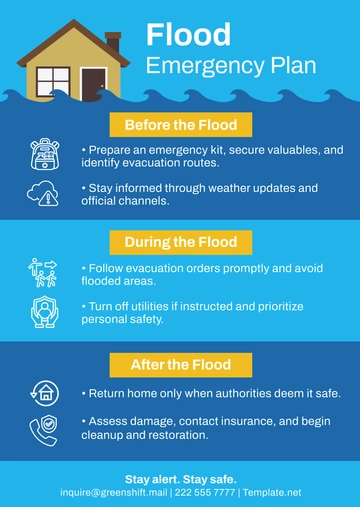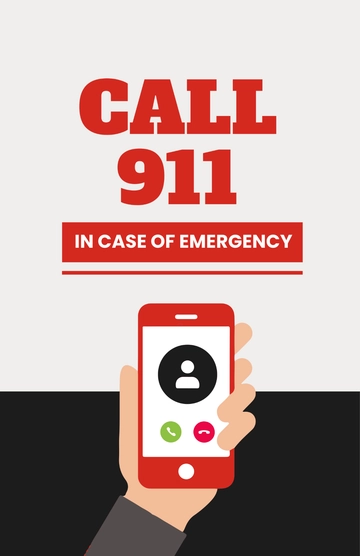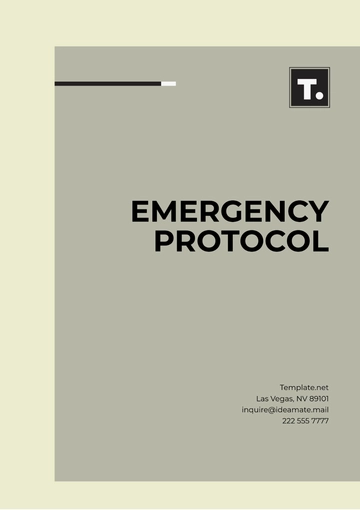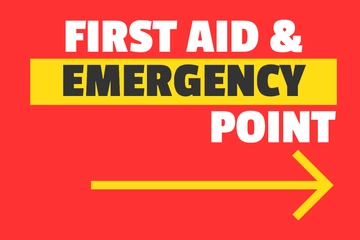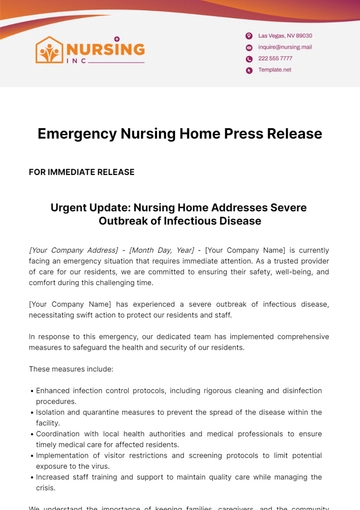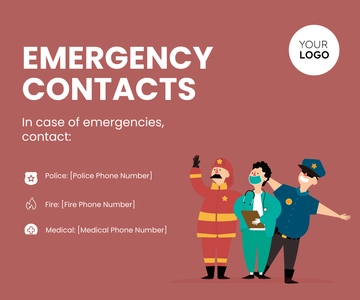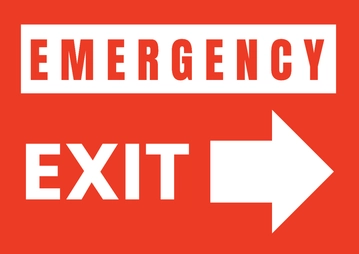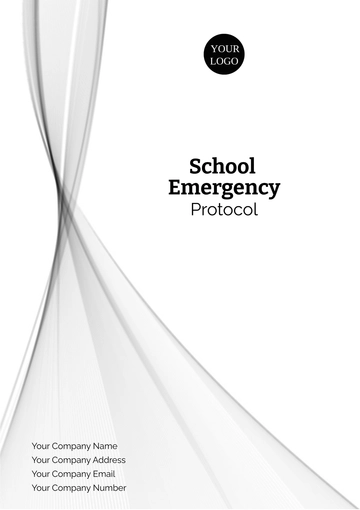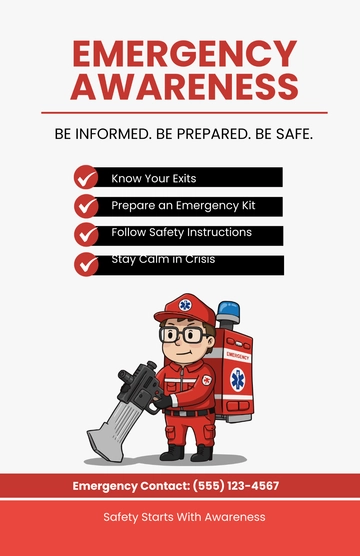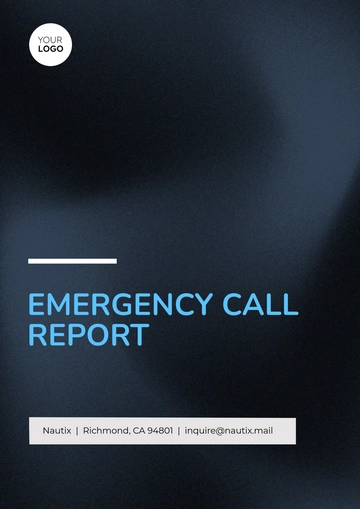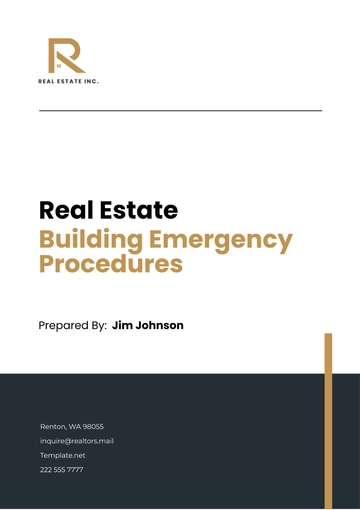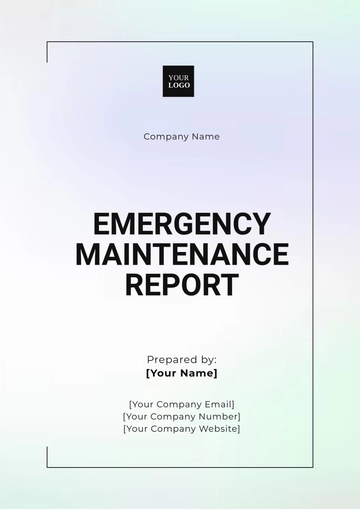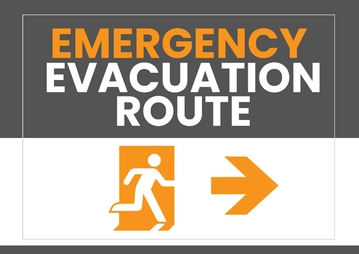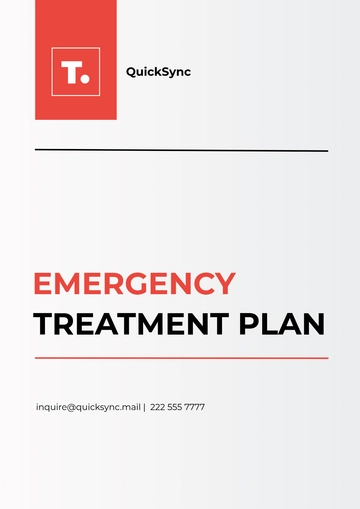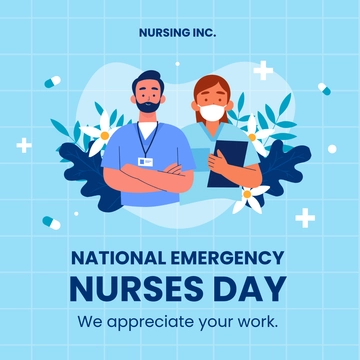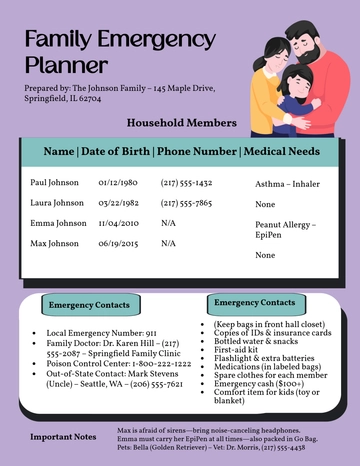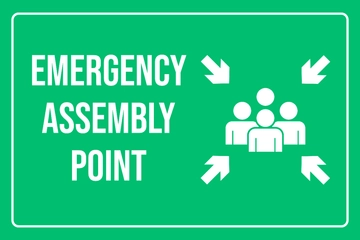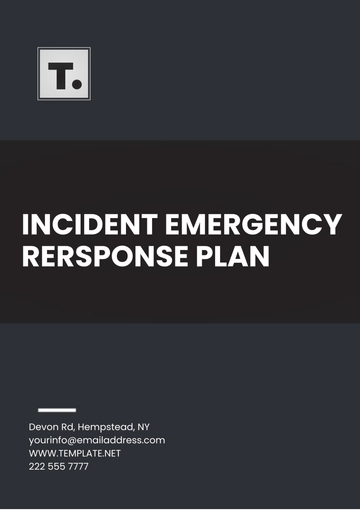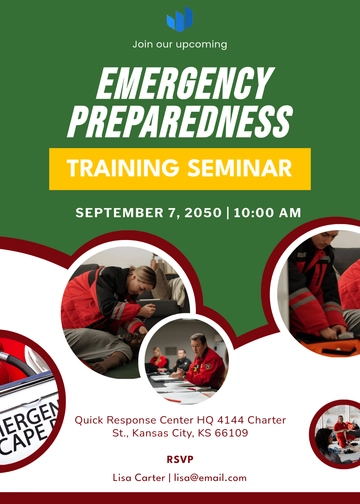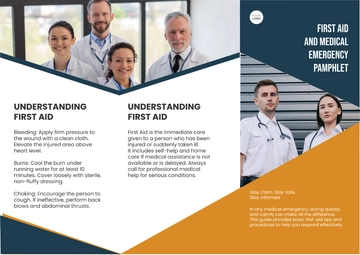Free Emergency Protocol Development
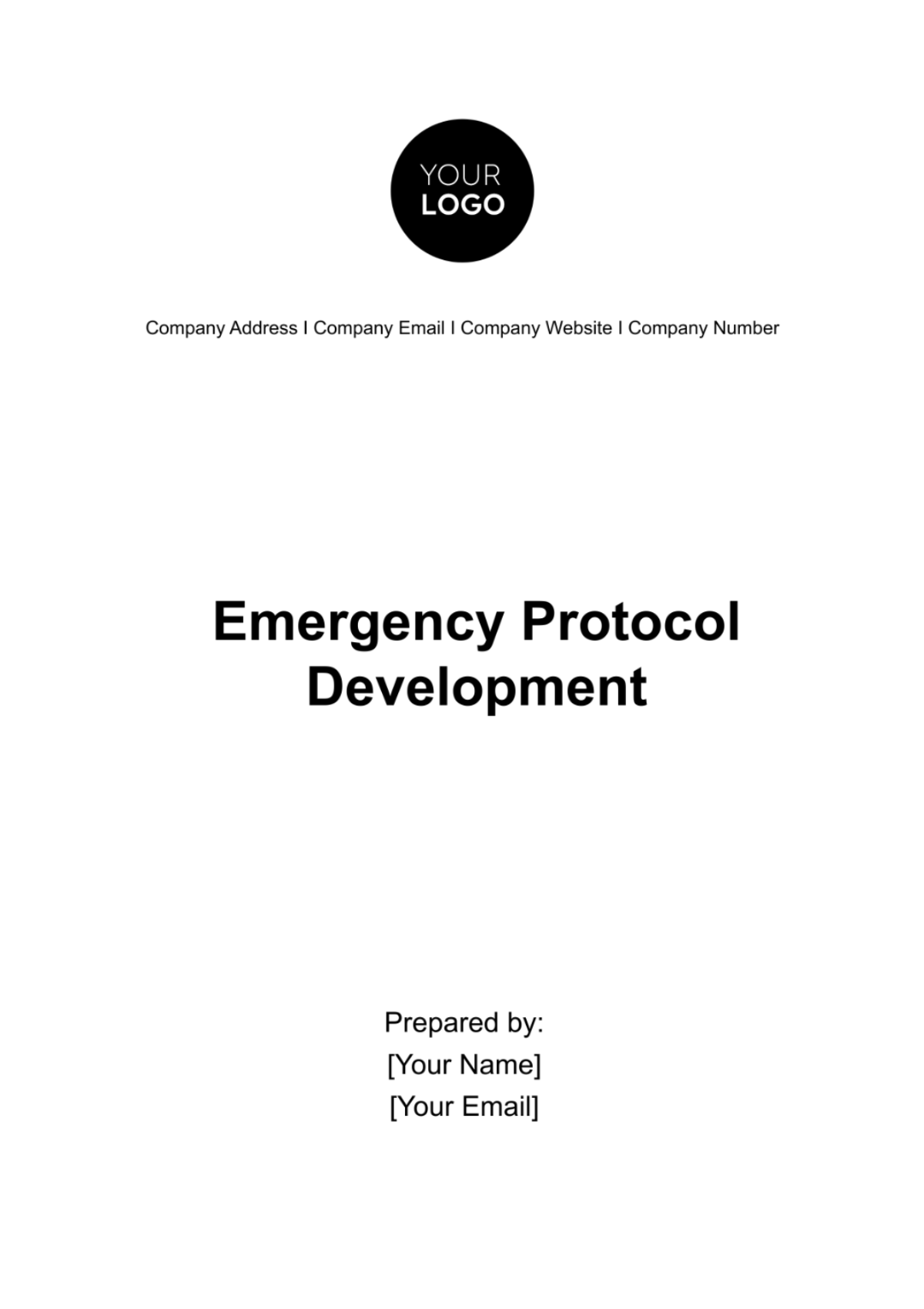
Introduction
A. Purpose
The purpose of this Emergency Protocol Development document is to establish a comprehensive set of guidelines and procedures for addressing emergency situations within the premises of [Your Company Name]. In accordance with our commitment to the safety and well-being of our employees, clients, and visitors, this document outlines the necessary steps to respond effectively to various emergency scenarios.
B. Background
[Your Company Name] recognizes that emergencies can occur without warning, and it is imperative to have a structured protocol in place to minimize risks, ensure the safety of all individuals on our premises, and mitigate potential harm. By adhering to the procedures outlined in this document, we aim to create a secure environment where everyone understands their roles and responsibilities during emergencies.
C. Document Purpose
This document serves as a vital reference for all employees, contractors, and visitors within our facilities. It is designed to provide clear and actionable guidance in the event of an emergency, ensuring a coordinated response to safeguard lives and property.
Objective
A. Main Objective
The primary objective of this Emergency Protocol Development is to establish a robust framework for responding to a wide range of emergency situations promptly and effectively. By doing so, we aim to protect the safety of our personnel, clients, and guests, as well as safeguard the integrity of our operations.
B. Specific Objectives
To define clear roles and responsibilities for individuals during an emergency.
To establish communication procedures that facilitate the timely dissemination of critical information.
To ensure that all employees are trained and prepared to respond appropriately to different emergency scenarios.
To evaluate and improve the effectiveness of our emergency response procedures through regular testing and drills.
Scope
A. Applicability
This emergency protocol applies to all employees, contractors, and visitors present within the premises of [Your Company Name]. It encompasses a wide array of emergency scenarios, ensuring that our organization is prepared to respond to various challenges effectively.
B. Covered Emergencies
The scope of this protocol includes, but is not limited to, the following types of emergencies:
Fires
Medical emergencies
Natural disasters (e.g., earthquakes, hurricanes)
Cybersecurity breaches or IT system failures
C. Exclusions
This protocol does not cover routine operational procedures and activities unrelated to emergency response.
D. Legal and Regulatory Compliance
We are committed to complying with all relevant local, state, and federal laws and regulations pertaining to emergency preparedness and response. This protocol is designed to align with these legal requirements.
Roles and Responsibilities
1. Emergency Response Team
[Your Name] - Emergency Response Team Leader
Email: [Your Email]
Phone Number: [Your Company Phone Number]
Responsibilities: The Emergency Response Team Leader is responsible for overall coordination and execution of emergency response efforts. This includes making critical decisions, liaising with external authorities, and ensuring the safety of all individuals on the premises.
[Eve Smith] - First Aid Officer
Email: [Email Address]
Phone Number: [Phone Number]
Responsibilities: The First Aid Officer is responsible for providing immediate medical assistance in the event of a medical emergency. This includes assessing injuries, administering first aid, and coordinating with medical professionals if required.
2. Evacuation Team
[Andrew Tiu] - Evacuation Team Leader
Email: [Email Address]
Phone Number: [Phone Number]
Responsibilities: The Evacuation Team Leader is responsible for leading the evacuation process during emergencies such as fires. This includes ensuring that evacuation routes are clear, conducting headcounts, and assisting individuals with mobility challenges.
Max Roberts - Floor Monitor (Floor 1)
Email: [Email Address]
Phone Number: [Phone Number]
Responsibilities: Floor Monitors are responsible for assisting with the evacuation of their designated floor. They help direct employees and visitors to the nearest exit and report any difficulties or concerns to the Evacuation Team Leader.
C. IT Response Team
Benjamin Turner - IT Response Coordinator
Email: [Email Address]
Phone Number: [Phone Number]
Responsibilities: The IT Response Coordinator is responsible for managing IT-related emergencies, such as cybersecurity breaches or system failures. They coordinate with the IT department to ensure the secure shutdown of systems and data protection.
Emergency Contact Information
In the event of an emergency, it is crucial to have quick access to the following contact information:
A. Emergency Services
Police: 911
Fire Department: 911
Medical Services: 911
B. Security Office
Phone Number: [Your Company Number]
C. Partner Company Contact (if applicable)
Contact: [Your Partner Company Name]
Email: [Your Partner Company Email]
Phone: [Your Partner Company Number]
Emergency Situations
This section outlines specific emergency scenarios and procedures to follow:
A. Fire
1. Alert
Activate the fire alarm by pulling the nearest alarm station.
Dial 911 to report the fire.
2. Response
Evacuate the building immediately using the nearest exit.
Do not use elevators during a fire.
Assemble at the designated muster point: [Specify location].
Await further instructions from the Evacuation Team Leader.
3. Fire Extinguishers
Fire extinguishers are located at [Specify locations].
Use a fire extinguisher only if you are trained and it is safe to do so.
4. Fire Wardens
Fire Wardens are designated employees responsible for assisting with evacuations and ensuring all individuals exit safely. Their names and contact information are posted on each floor.
B. Medical Emergency
1. Alert
In the event of a medical emergency, promptly dial 911 and provide the following information:
Nature of the medical emergency.
Exact location within the premises.
Any specific medical conditions of the individual in distress.
2. Response
Designate a colleague to stay with the individual in need of medical assistance until professional help arrives.
Administer basic first aid if qualified and if it doesn't put you or the injured person at risk.
Retrieve the nearest automated external defibrillator (AED) if available and follow its instructions.
Keep the individual as comfortable as possible until medical professionals take over.
Natural Disaster
1. Alert
Stay informed about potential natural disasters through local weather alerts and announcements.
Designate an employee or team responsible for monitoring weather conditions, especially during severe weather seasons.
2. Response
In the event of an imminent natural disaster, such as an earthquake, hurricane, or tornado, follow these guidelines:
If indoors, take cover under sturdy furniture or move to an interior room away from windows.
If outdoors, seek shelter immediately.
After the disaster has passed, check for injuries and administer first aid as needed.
Account for all employees and visitors and report any missing persons to the Evacuation Team Leader.
Cybersecurity Breach
1. Alert
In the event of a suspected or confirmed cybersecurity breach, immediately contact the IT department by calling [IT Contact Number].
2. Response
The IT department will initiate the following cybersecurity breach response procedures:
Isolate affected systems to prevent further damage.
Collect evidence and logs related to the breach for investigation.
Notify appropriate authorities and regulatory bodies, if required.
Implement recovery and mitigation strategies as directed by the IT Response Coordinator.
3. Data Breach Notification
In the event of a data breach that involves personal information, affected individuals will be notified in accordance with applicable laws and regulations.
Communication will be handled by [Your Company Name] and may include guidance on protecting their information.
Response Procedures
A. Evacuation Procedures
1. Evacuation Plan
The evacuation plan is detailed in the attached document titled "Evacuation Plan".
Primary evacuation routes are marked with green exit signs, and secondary routes are marked with blue exit signs.
2. Evacuation Team Responsibilities
The Evacuation Team, led by [Andrew Tiu], plays a crucial role during evacuations.
Responsibilities include guiding employees and visitors to the nearest exits, conducting headcounts, and providing assistance to individuals with disabilities.
3. Evacuation Drills
Regular evacuation drills are conducted quarterly, and the schedule is available on the company intranet.
These drills familiarize employees with evacuation procedures and ensure an efficient response during real emergencies.
First Aid Procedures
1. Location of First Aid Kit
First aid kits are located in designated areas on each floor, including near stairwells and break rooms.
Contents of the first aid kit include bandages, antiseptic wipes, scissors, and adhesive tape.
2. First Aid Team
[Eve Smith] is the designated First Aid Officer responsible for administering first aid during medical emergencies.
In the event of a medical emergency, Eve will assess injuries, provide first aid, and coordinate with medical professionals if necessary.
C. Shelter-in-Place Procedures
1. Shelter Locations
Designated shelter locations are marked with "Shelter-in-Place" signs and are located on each floor.
Employees and visitors should proceed to these areas during emergencies such as severe weather events.
2. Shelter-in-Place Supplies
Shelter-in-place locations are equipped with emergency kits containing flashlights, blankets, portable radios, and non-perishable food and water supplies.
D. IT Systems Shutdown Procedures
1. Secure Shutdown Protocol
In the event of a cybersecurity breach or IT system failure, the IT Response Team, led by [Benjamin Turner], will initiate a secure shutdown protocol.
This protocol ensures the protection of sensitive data and minimizes potential damage to IT systems.
2. Data Backup Procedures
Data backups are performed daily, and backup data is stored in an offsite location.
The IT department maintains a record of backup procedures and data storage locations (refer to the IT Data Backup Policy for details).
Communication Plan
A. Emergency Communication Channels
During emergencies, communication is vital. The following channels will be used to disseminate information:
Public Address (PA) system announcements
Email alerts to all employees
Text messages sent to registered mobile phones
Company mobile app notifications
B. Emergency Notification Systems
[Emergency Alert Pro] - This system is capable of sending mass notifications via multiple channels simultaneously.
Training and Drills
A. Employee Training
All employees undergo comprehensive training on emergency procedures during orientation and annually thereafter.
Training modules include evacuation drills, first aid training, and cybersecurity awareness workshops.
B. Regular Drills
[Your Company Name] conducts regular emergency drills, including fire drills, medical emergency simulations, and cybersecurity breach scenarios.
These drills are scheduled bi-annually, and employees are informed in advance.
C. Evaluation and Feedback
After each drill, an evaluation is conducted to identify strengths and areas for improvement.
Employees are encouraged to provide feedback through anonymous surveys, and findings are used to refine emergency response procedures.
Testing and Evaluation
A. Testing Procedures
[Your Company Name] is committed to regularly testing the effectiveness of our emergency protocols.
Testing procedures will be conducted using various scenarios to assess the response of employees and the functionality of our systems.
B. Types of Tests
[Your Company Name] conducts the following types of tests:
Desktop Exercises: Simulated scenarios where employees discuss and analyze emergency procedures.
Partial Tests: Limited-scale tests focusing on specific aspects, such as evacuation drills.
Full-Scale Tests: Comprehensive tests involving all aspects of the emergency protocol, including evacuation, first aid, and IT system shutdown.
C. Evaluation Criteria
The effectiveness of our emergency response will be evaluated based on the following criteria:
Timeliness of response
Clarity and accuracy of communication
Coordination among response teams
Compliance with established procedures
Identification of areas for improvement
D. Post-Test Analysis
After each test, a post-test analysis will be conducted to assess the strengths and weaknesses of our response.
Findings will be used to update and enhance the emergency protocol.
Maintenance and Updates
A. Review Process
The Emergency Protocol Development document will undergo an annual review.
A dedicated committee, including representatives from various departments, will oversee the review process.
B. Document Revisions
All revisions to the document will be documented in the "Document Revision History".
Revisions may be prompted by regulatory changes, lessons learned from testing, or advancements in emergency response best practices.
C. Communication of Updates
Any updates to the emergency protocol will be communicated to all employees via email and through the company intranet.
Training sessions will be conducted to ensure that all employees are aware of and understand the changes.
- 100% Customizable, free editor
- Access 1 Million+ Templates, photo’s & graphics
- Download or share as a template
- Click and replace photos, graphics, text, backgrounds
- Resize, crop, AI write & more
- Access advanced editor
Discover the ultimate solution for emergency protocol development with Template.net's comprehensive template. Fully editable and customizable, it streamlines the process with ease. Crafted for efficiency, it's conveniently editable in our Ai Editor Tool, ensuring seamless adaptation to your specific needs. Simplify protocol creation today.
